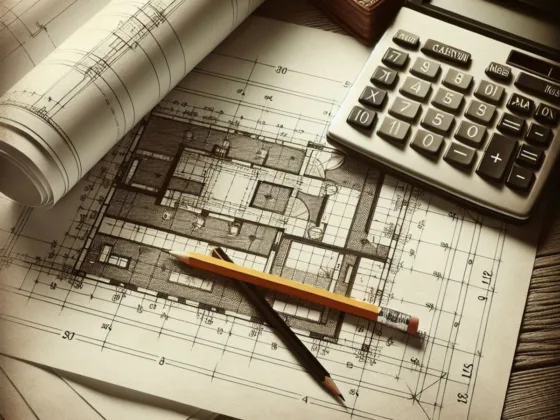Table of ContentsShow
Introduction
Embarking on a home renovation can be both exciting and nerve-wracking. It’s not just about simple tasks like painting or demolition; it’s about creating a space that truly represents your style and meets your needs.
Key elements for a successful renovation include:
- Strategic Planning: Having a solid game plan is crucial for any project. It serves as the roadmap from start to finish.
- Research: Knowledge is power. Understanding the ins and outs of renovation can help you avoid potential issues.
- Budgeting: Money matters, so it’s important to be mindful of your finances. A well-planned budget can reduce stress during the process.
In this article, we’ll guide you through the world of home renovation, covering everything from assessing your home’s condition to completing the project smoothly. Whether you’re looking for tips on finding the right contractor or advice on renovation planning, consider this your go-to guide for turning your house into your dream home. Let’s get started!
1. Assessing Your Home’s Needs
Before you start your home renovations, it’s important to assess your home thoroughly. This initial step is like understanding the plan of your current space — knowing its strengths and identifying areas that require improvement or redesign.
Checking the Structure
The foundation of your home is crucial. It needs to be strong and stable. Here are some things you should do:
- Hire a professional inspector to check for cracks or shifts in the foundation.
- Make sure the roof is durable and doesn’t have any leaks.
- Inspect the plumbing and electrical systems to see if they need updates to meet current codes.
This inspection will help you find any urgent issues that could affect the safety and the success of your renovation.
Evaluating Functionality
Next, think about how each room serves its purpose based on your lifestyle. Here are some questions to ask yourself:
- Does the kitchen layout work well for how you cook?
- Is the bathroom layout convenient for your busy mornings?
- Are the living spaces flexible enough for both relaxation and entertainment?
Making a checklist for each area in your home can assist you in figuring out which changes will have the biggest impact on your daily life.
Setting Priorities
Now that you have the results of your assessment, it’s time to prioritize. Think about which renovations will improve your quality of life and align with your long-term plans for the property. To make this easier:
- Address immediate concerns: Start by fixing any safety hazards or major inconveniences.
- Consider cost and impact: Some updates may provide more benefits in terms of comfort or property value.
- Plan for the future: Focus on renovations that will last or can be adjusted as your needs change.
By carefully evaluating every aspect of your home’s current condition, you’ll establish a strong base for a renovation that not only looks amazing but also brings significant value to your daily life.
2. Setting Clear Renovation Goals
Embarking on a renovation journey without clear goals is like sailing without a compass—exciting, but possibly chaotic. Defining renovation goals involves a laser focus on aesthetics, functionality, and the value-add to your abode. It’s not just about choosing the prettiest paint color; it’s also ensuring that your home meets your lifestyle needs and boosts its worth in the long haul.
Aesthetics: Creating Your Desired Look
When considering aesthetics, think about the visual transformation you wish to achieve. Is it a minimalist Scandinavian look or perhaps a cozy rustic charm? Remember, the style you choose should resonate with your personal taste and stand the test of time.
Functionality: Designing for Your Lifestyle
On the functionality front, reflect on how each space serves your daily life. Maybe it’s an open-plan kitchen that allows you to interact with family while cooking or a home office setup that maximizes productivity.
Value-Add: Increasing Your Property’s Worth
Increasing property value is also a key driver. Consider updates that bring the best return on investment, such as:
- Kitchen Remodels: Often the heart of the home and top on buyers’ checklists
- Bathroom Upgrades: Functional yet stylish improvements can be deal-makers
- Energy-Efficient Solutions: Think insulation, modern windows, and eco-friendly heating systems
Here are examples of specific renovation goals to spark ideas:
- Transforming an unused attic into a vibrant playroom for kids
- Adding an ensuite bathroom to the master bedroom for added privacy
- Installing smart home technology for enhanced security and convenience
By setting well-defined objectives, your renovation project becomes more than just a series of tasks—it evolves into a strategic upgrade of your living space. Keep these goals at the forefront as you navigate through each decision and selection in your renovation roadmap.
3. Researching Costs and Establishing a Budget

Embarking on your home renovation journey comes with its unique set of financial challenges. It’s not something you can just dive into without a well-thought-out budget in place. Researching costs is an essential step that ensures your project doesn’t turn into an unmanageable financial nightmare.
To get started with research renovation cost, consider all the elements involved in your project, including but not limited to:
- Materials: This could be anything from paint to flooring materials, appliances, fixtures, etc.
- Labor: The cost of hiring professionals for various tasks like plumbing, electrical work, carpentry, and more.
- Permits: Depending on your location and the extent of your renovation, you may need to secure certain permits.
But wait! There’s more. Keep in mind that there are often hidden expenses that sneak up on you during the process. This could include things like transport costs for delivering materials or even fees for disposing of old fixtures and construction waste.
A good rule of thumb is to add a contingency allowance to your budget. A typical recommendation is 10%-20% of the overall cost estimate. This buffer helps cover unexpected costs or price variations that may arise during the project.
Creating a realistic budget involves being honest with yourself about what you can afford while still allowing room for flexibility. Here are a few tips:
- Prioritize: Determine which parts of your renovation are most important and allocate funds accordingly.
- Compare Quotes: Get estimates from multiple contractors to ensure you’re getting fair market value.
- Track Expenses: Keep detailed records of all costs throughout the project to prevent overspending.
Remember, thorough research and careful budgeting are foundational steps in ensuring a smooth, stress-free renovation experience.
4. Hiring the Right Professionals
The journey of home renovation is exciting, but it also comes with its own set of challenges. To make your architectural dreams come true, it’s important to hire trustworthy contractors, specialized tradespersons, and designers who can bring their expertise to the table.
Benefits of Hiring Professionals
There are several advantages to hiring professionals for your home renovation:
- Experience and Expertise: Professionals have years of experience and specialized knowledge in their respective fields. This ensures that the work done on your home is of high quality.
- Smooth Coordination: With professionals handling your renovation project, you can expect better coordination between different tasks and trades. This leads to a smoother workflow and less stress for you.
- Time Management: By delegating the renovation work to professionals, you free up your own time to focus on other important aspects of your life.
- Knowledge of Regulations: Building codes, permit requirements, and safety regulations can be complex and confusing for homeowners. Professionals are well-versed in these regulations and can ensure that your renovation project complies with all necessary laws.
- Avoiding Mistakes: Renovations can be costly, especially if mistakes are made along the way. Professionals have the skills and experience to identify potential pitfalls and avoid costly errors.
Finding the Right Individual or Firm
When it comes to hiring professionals for your home renovation project, here are some tips to keep in mind:
- Check Licenses: Ensure that any contractors or tradespersons you hire are properly licensed to operate in your area. A valid license is a sign of professionalism and adherence to industry standards.
- Review Portfolios: Take the time to look at past projects completed by the professionals you’re considering. This will give you an idea of their style and whether it aligns with your design vision.
- Get Multiple Quotes: Don’t settle for the first quote you receive. Instead, gather multiple quotes from different professionals and compare them. This will help you make a more informed decision about who to hire.
It’s also worth reaching out to friends or family members who have recently completed similar renovation projects. They may be able to provide recommendations based on their own experiences.
Remember, hiring the right professionals is not just an expense – it’s an investment in your home’s future. These experts have the knowledge, skills, and experience to bring your vision to life while also adding value to your property.
In our next blog post, we’ll be taking a closer look at the various stages involved in a home renovation project. Stay tuned!”
5. Understanding the Renovation Process
Embarking on a home renovation journey is exactly that – a journey. This adventure starts with planning and ends with the exciting finishing touches. However, there are crucial steps in between that ensure a successful outcome.
1. Planning and Design
The initial stage is all about creating your vision and laying out the roadmap for your renovation project. This includes defining your goals, finalizing designs, selecting materials, and determining timelines. A well-thought-out plan will serve as your guiding light throughout the process.
2. Demolition
Once you have a solid plan in place, it’s time to tear down what no longer serves your home. Demolition involves removing old structures or elements that need replacement or refurbishment. Remember, safety first! Always use proper protective equipment during this process.
3. Construction
Next comes construction – the phase where your plans start to take physical shape. Whether it’s building an extension, installing new cabinets in the kitchen, or upgrading bathroom fixtures, this is where all your planning pays off.
4. Finishing Touches
After construction comes the exciting part: adding the finishing touches. Painting walls, installing light fixtures, laying down flooring – these elements bring together all the hard work and make your home truly yours.
One crucial aspect not to be overlooked in this process is obtaining necessary permits and approvals. These legal documents ensure that all renovations comply with local building codes and regulations. It’s essential to secure these permits at the appropriate stages of the process to avoid any potential legal issues down the line.
This overview gives you a glimpse into what to expect during your home renovation process. Each stage requires careful attention to detail and patience. So buckle up and enjoy the ride!
6. DIY vs. Professional Work: What Can You Do Yourself?
Embarking on a home renovation can stir up a mix of enthusiasm and the urge to roll up your sleeves with some good old-fashioned DIY work in renovation. There’s a certain charm to infusing your home with the sweat and love that only personal handiwork can provide, not to mention the potential cost savings. Before you dive in, let’s explore what tasks might be ripe for your DIY ambitions and where it’s wise to call in the cavalry.
DIY-Friendly Projects:
- Painting Walls: With a steady hand and some patience, giving rooms a fresh coat of paint is manageable for most.
- Installing Shelving: For those who are handy with a drill, adding or replacing shelving is an effective way to upgrade storage space.
- Upgrading Fixtures: Swapping out old doorknobs, light fixtures, or faucets can be straightforward and transformative.
- Landscaping: Greenthumbs can make significant improvements to curb appeal through gardening and other outdoor projects.
The Skill Question:
Success in DIY work hinges on an honest assessment of your skills. Underestimating the complexity of a project can lead to less-than-desirable results that may require professional correction later—often at greater expense.
Limitations and Risks:
- Structural Changes: Alterations affecting the home’s structural integrity are no-fly zones for unqualified DIYers.
- Electrical Work: Beyond simple tasks like changing out light fixtures, electrical work demands professional knowledge to prevent safety hazards.
- Plumbing: Major plumbing jobs can lead to leaks or water damage if not executed correctly.
- Permit Requirements: Certain renovations require permits; professionals ensure compliance with local building codes.
Enthusiasm for tackling renovation tasks is admirable, yet recognizing limitations is crucial. Complex or specialized tasks demand expertise that only seasoned professionals possess. Ensuring that critical work is done properly safeguards both your investment and the occupants’ safety. By balancing what you can do yourself with areas where you need expert intervention, you strike a harmonious chord between personal involvement and professional excellence in your home renovation journey.
7. Starting Small: The Significance of Prioritizing and Phasing Your Renovation
Embarking on a full-scale home renovation can feel overwhelming, especially when you’re on a tight budget. But don’t worry! Doing smaller renovations or focusing on priority areas can be just as satisfying—and much more manageable. Here’s why starting small and using project phasing can lead to a successful home makeover:
Why Start Small?
1. Identify High-Impact Areas
Think about which parts of your home will benefit most from an upgrade. Is it the outdated kitchen cabinets that need a modern touch, or maybe the living room that could use some new paint? By pinpointing these areas, you can make noticeable improvements without spending too much.
2. Make Incremental Upgrades
Breaking down your project into smaller tasks helps you stay motivated. For example, you could focus on installing new light fixtures in the hallway this month and then update the bathroom fixtures next month. Each step brings a sense of accomplishment and gets you closer to your dream home.
3. Manage Your Budget
Smaller projects usually come with smaller costs. This approach allows you to better manage your finances and reduces the risk of going over budget. It also gives you time to save up for the next phase without pausing all progress.
4. Maintain Living Quality
Let’s be honest—renovations can be disruptive. That’s why phasing is beneficial; it lets you keep certain parts of your home functional while work is being done elsewhere, minimizing the impact on your daily life.
The Importance of Design Consistency
When planning out these phases, always consider how each part fits into the bigger picture. Making consistent design choices ensures that every phase flows smoothly into the next, creating a cohesive look throughout your evolving home style.
By approaching renovations in this strategic way, you not only manage your resources effectively but also get to enjoy the excitement of transformation one step at a time.
If you’re looking for more guidance on these renovation strategies, check out these helpful articles on phased remodeling, the design planning phase, and top considerations before starting a renovation to ensure a smooth and successful home transformation.
8. Drawing Inspiration from Design Sources
Embarking on a home renovation project can be both exciting and overwhelming, especially when it comes to choosing the design style. Finding ideas for your home renovation can come from different places, so it’s important to be open-minded.
1. Home Improvement Magazines
A classic yet effective source of inspiration, design magazines offer plenty of ideas shown through beautiful pictures. They often showcase creative designs, expert advice, and the latest trends in home decoration.
2. Online Platforms
The internet has made it easy to find design ideas from all over the world. Websites like Pinterest or Houzz are full of home renovation inspirations, with millions of images displaying every possible design style.
Instagram and Facebook are great platforms for discovering new trends and designs. Follow accounts of professional interior designers, home décor influencers, or even hashtags related to home renovation for a constant flow of inspiring content.
4. Open Houses and Showrooms
Nothing beats seeing designs in person. Open houses or showrooms give you the chance to experience how different elements come together harmoniously.
Once you have gathered your ideas, creating a mood board can be incredibly helpful in refining your vision. This visual collage could include pictures of rooms that inspire you, samples of fabric or wallpaper you love, or even items like knobs and handles. It’s a perfect way to see how different elements work together before implementing them in your own space.
Remember, your home should represent who you are and how you live. While it’s good to get inspiration from various sources, don’t be afraid to add your personal touch. Happy designing!
9. Staying Organized: Tools and Techniques for Project Management
Embarking on a home renovation journey can be thrilling, but without proper organization, it can quickly become overwhelming. Thankfully, there’s a variety of tools available to help manage your renovation project effectively.
Task Tracking Apps
From scheduling contractor meetings to remembering when to order the sink for the new bathroom, numerous tasks need tracking in a renovation project. Apps like Trello or Asana come in handy here. They allow you to set up boards for different aspects of your renovation, add due dates, and even assign tasks if you’re not the only decision-maker in the house.
Budgeting Spreadsheet Templates
Money matters! And keeping a close eye on your budget is crucial to avoid nasty surprises. A simple Excel spreadsheet can do the trick for most, but online tools such as Google Sheets offer more accessibility from various devices. You can even find pre-made templates online designed specifically for renovations – all you need to do is plug in your numbers!
Communication Platforms
Clear communication between you and your contractors or suppliers is vital for a smooth renovation process. Email works fine, but it might not be the most efficient method especially when dealing with multiple parties. Communication platforms like Slack or Microsoft Teams allow for real-time conversations, file transfers, and even video calls – all neatly organized into different channels.
The right use of these tools will not just keep your sanity intact throughout the process but also ensure that everyone remains on the same page and that your project proceeds as planned.
For more comprehensive guidance on managing renovation projects, you may refer to this construction project management guide.
10. Dealing with Challenges and Adapting to Changes
Renovating a home is like going on an adventure—exciting yet full of surprises. It’s normal to encounter difficulties during the renovation process, such as unexpected structural issues, going over budget, or experiencing delays. The key to handling these challenges is being flexible. While having a solid plan is important, being able to adapt is what will truly keep your renovation journey on track.
- Expect the Unexpected: No matter how well you plan, problems can arise—like finding outdated wiring or plumbing when walls are opened up. Instead of just fixing these issues, see them as opportunities to upgrade and increase the value of your home.
- Stay Open-Minded: When changes need to be made, having a flexible mindset will be your greatest asset. It allows you to explore new possibilities and make choices that move your project forward without compromising quality.
- Seek Professional Help: If you encounter difficulties with your contractor or come across a complex problem, don’t hesitate to seek advice from experts. Sometimes, their perspective can provide simple solutions that save time and money in the long run.
- Consider Mediation: Disagreements can happen even with the best teams. If tensions escalate, consider mediation as a way to resolve conflicts constructively. By keeping communication channels open and respectful, everyone can stay focused on the ultimate goal: transforming your home beautifully and efficiently.
Remember, being adaptable doesn’t mean settling for less—it means being strategic in achieving the best possible outcome given changing circumstances. With this approach, you’ll be able to overcome challenges and move closer to creating your dream home.

Conclusion
Embarking on a home renovation journey can be an exciting yet challenging endeavor. Remember, success lies in meticulous planning and execution.
Here’s a quick recap of the essential steps discussed in this article:
- Assessing Your Home’s Needs: Understand the current state of your home to determine what needs attention.
- Setting Clear Renovation Goals: A clear vision leads to a more targeted approach.
- Researching Costs and Establishing a Budget: Know your financial limits and plan accordingly.
- Hiring the Right Professionals: Collaborate with experienced professionals for quality results.
- Understanding the Renovation Process: Familiarize yourself with the stages involved in your renovation journey.
- DIY vs. Professional Work: Balance between self-effort and professional assistance based on the complexity of tasks.
- Starting Small – Prioritizing and Phasing Your Renovation: Gradual improvements can still bring significant changes.
- Drawing Inspiration from Design Sources: Turn to various sources for creative insights.
Armed with these nuggets of wisdom, it’s time to take that first confident step toward making your dream home a reality.
Remember, while laying strong foundations is crucial, maintaining momentum is equally essential for a successful renovation journey. Expect some hiccups along the way, but remember, challenges are growth opportunities.
FAQs (Frequently Asked Questions)
The excitement and challenges of a home renovation project should be approached with proper planning, research, and budgeting to ensure a successful outcome. This article provides an overview of where to start the home renovation journey, covering topics such as assessing the home’s needs, setting clear renovation goals, researching costs and establishing a budget, hiring the right professionals, understanding the renovation process, considering DIY work, prioritizing renovations, drawing inspiration from design sources, staying organized with project management tools, and dealing with challenges and changes.
Assessing the current state of the home is crucial as the first step in any renovation project. This includes evaluating both the structural integrity and functional aspects of different areas in the house. By prioritizing renovation needs based on this assessment, homeowners can ensure that their project addresses the most critical areas for improvement.
It’s important to define specific goals for the renovation that encompass desired aesthetics, functional improvements, and potential increase in property value. This involves considering both the visual appeal of the project as well as its practicality and long-term benefits. The article provides examples of common renovation goals to inspire readers to set their vision for their projects.
Comprehensive research on renovation costs is essential, including materials, labor, permits, and other relevant factors. The article also provides tips on creating a realistic budget with allowances for unexpected costs or price variations during the project.
Engaging experienced and reliable professionals such as general contractors, specialized tradespersons, and interior designers is beneficial for ensuring quality workmanship and smooth coordination throughout the renovation process. The article also offers guidance on finding and selecting the right individuals or firms for each role by checking licenses, viewing portfolios, and obtaining multiple quotes for comparison.
The article discusses potential areas where homeowners can engage in DIY (Do-It-Yourself) work to save costs. However, it also emphasizes the limitations and risks associated with DIY work, highlighting the need to engage professionals for complex or specialized tasks beyond average homeowners’ capabilities.








